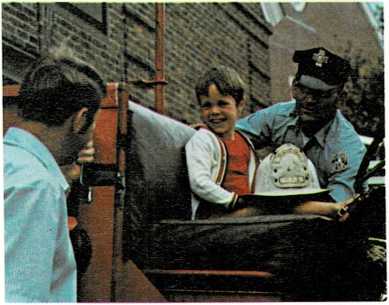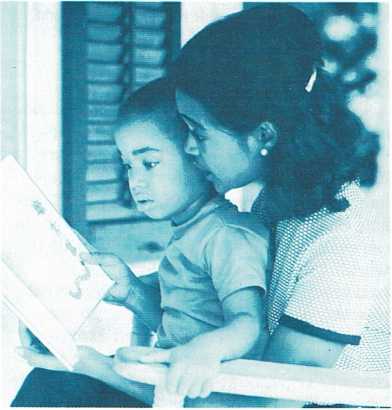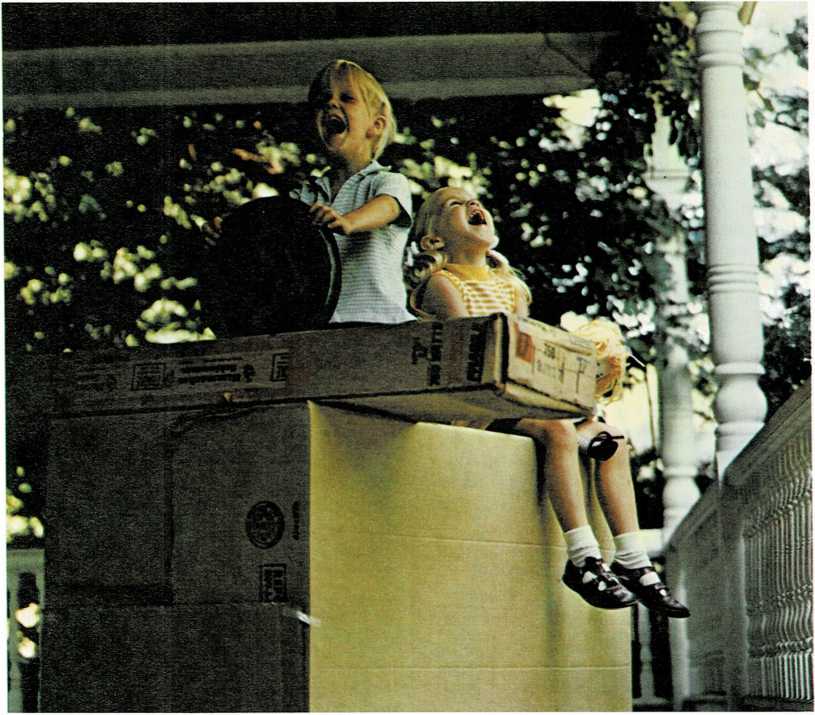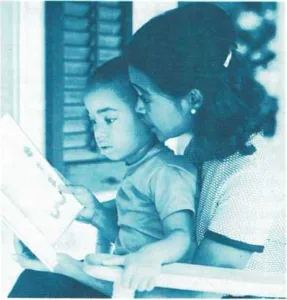The preschooler’s education

Preschoolers’ constant questions reflect another side of development in
these years— their intense curiosity and their thirst for knowledge.
One of the most outstanding characteristics of preschoolers is that they
are so completely ready to learn—about the world around them, about
themselves as part of that world, about other children, and about
adults. Preschoolers are curious, open, and responsive. Their eyes go
out to all that is around them. Their ears pick up what is around them.
Their hands are tools for fascinated exploration.
One of the most important tasks for parents is to keep this burning
curiosity and charmed sense of wonder alive. Children will go far with
curiosity and wonder. Without them, now and in the years ahead, children
will have to be pushed or pulled or lured.

Trips to a fire station or other nearby places are treats for a
preschooler.
Most parents appreciate curiosity. Sometimes, however, without meaning
to, they discourage it. Curious children may trouble and frighten
parents. Parents worry about safety. When parents’ irritations or their
worries mount, the danger is that children will hear No and Don’t
and Be careful and Watch out too often. Parents must take
precautions, of course. But at the same time, they should make sure that
the world does not seem like a “bad” or “dangerous” or “not nice” place
to the child. Curiosity cannot stand a never-ending stream of
discouragement.
Parents must also be careful not to let their children’s curiosity
wither from lack of stimulation. Children desperately want to know more
and to understand their world.
Trips
Trips are one of the best ways of bringing new, stimulating,
mind-stretching experiences to young children. Preschoolers are
basically uninformed—they simply do not know much yet because they
have not lived long enough, or experienced enough. No one can really
tell children at this age about the world. The children do not yet have
the background or knowledge to understand the meaning of the words. They
have to see things first. They need firsthand experiences. Later, words
can build on these experiences. Trips, now, are a perfect solution to
learning for preschoolers.
Trips for preschoolers should be short. Young children tire easily, and
a tired, fussy
child learns little. The destination does not have to be spectacular,
either. To a young child, the filling station, the supermarket, the
florist shop, the post office, the barn, the stream, the airport, and
other everyday locations are a treat.
Time transforms an everyday “trip to mail a letter” or “trip to get a
quart of milk” into an educational experience. A good trip for a child
has a slow, relaxed pace with time for talking en route, both coming and
going. There ought to be time, too, for several short stops along the
way. Unexpected side explorations can sometimes be better than the main
trip itself. And at any stop, en route or at your destination, your
preschooler needs time to stand and watch, time to touch, time to
explore. Preschoolers cannot take in all they want to know at a glance.
On trips, there are countless opportunities to point out sights your
child might otherwise miss. And there are countless opportunities to ask
provocative questions that might not otherwise occur to the child.
Stories
Good storybooks, like good trips, stimulate children. Stories bring a
part of the world closer to them so that they can take a closer

Story time is a time for companionship and conversation. Try to make
it a daily event.
look at it and come to understand it more fully. Stories may be
make-believe or about real people and events. They may involve animals
that seem almost human. They may include more adventure than most people
have in their everyday lives. But fiction or nonfiction, children’s
books help preschoolers get a better handle on the people, the events,
the objects in the real life that exists around them.
The trick in reading a story well to your child is the same trick as in
taking the child on a successful trip. Take your time. Do not rush to
the end of the story. Let your child interrupt to ask a question, even
if it takes you both off on a tangent. Story time should be a daily
event, and often an evening event—a time for companionship and
conversation between you and your preschool child.
Enriching the preschooler’s play
Language and social development, increased knowledge, longer attention
span, and vastly improved physical coordination all combine to produce
the most distinctive characteristic of preschool children. They are
highly imaginative and have the special capacity to make believe. They
can take on any roles that suit their fancy. There should be no fixed
roles for boys and for girls. The children themselves can become
anything they want to be—baby, cowboy, wild animal. A chair can become
a horse or a plane or an animal cage. To adults looking on, preschoolers
seem to spend all of their time “just playing.” The play of preschool
children is far from a waste of time, however. It is highly significant
activity that teaches important emotional, intellectual, and social
lessons.
Children at play draw on what they know. They very often play house, for
example, mostly because life at home is what they know best. The play is
imaginative, but it is firmly grounded in reality. The more children
know—the more places they have been, the more things they have
seen—the richer their play will be.
Preschoolers need toys and materials, too, with which to carry out their
play. The same toys are for all to use. They are not ear-

Boxes are toys that stretch a child’s imagination. They can be
whatever the child wants them to be—a car, a rocket, a grocery
store, a house.
marked “this is for boys” and “this is for girls.” Good preschool toys
set up rough outlines and give the child’s fertile mind freedom to fill
in the details. A tricycle, for example, is obviously some kind of
moving vehicle, but the child decides whether it is a horse, ambulance,
police car, ship, rocket, plane, bus, truck, fire engine, or tank. Among
the best playthings are boards, boxes, blankets, sand, cartons, wagons,
chairs, dolls, simple cars and boats, and other materials that can be
used in various ways. They let the richness come from a child’s own flow
of images.
One kind of imaginative activity is special to this age—creating an
imaginary playmate. Youngsters without many real age mates, and
youngsters who have no brothers
or sisters, are most apt to make up an imaginary friend. But even
youngsters with many real-life pals may add one more: their own,
personal, not-seen-by-adults child. The imaginary playmate can be
someone to boss or someone who gives support and comfort. This unseen
friend is important to a child. Try to make the few short-term
adjustments needed to fit this new member into your home.
Television and the preschooler
The fascination television holds for preschoolers is an indication of
their thirst for stimulation. TV’s fast-moving pictures and continuous
sound lure many young children into watching contentedly for hours. For
better or for worse, television is a teacher. Television viewing affects
children’s language and their awareness of the world around them.
Television also provides relaxation and entertainment. However, viewing
presents many hazards. There is reason to worry about the impact of TV’s
violence on the feelings and morals of youngsters, to be concerned about
the impact of commercials on their taste and the effect of long hours of
passive watching on their personality. One must also be concerned
because too much television viewing can rob a family of time for talk
and shared activities, and can also deprive children of creative play
with their age mates. The television set should not become a “baby
sitter.”
Some families react to these concerns by having no TV set. When TV is
available, it is important for parents to make thoughtful decisions
about what programs to view and how long children may watch. Involving
preschoolers in these decisions will offer them learning experiences
about choices and responsibilities.
It is also wise to watch television often enough with your children so
that you can discuss with them the ideas, feelings, and values the
programs may generate. You may also wish to consider becoming involved
with groups working to improve television for preschoolers. If good
programs are available, and if viewing hours are wisely regulated,
television can be a positive educational force. For further information
see [Children and television] in For Special Consideration.
Schools for the preschooler
Many 3- and 4-year-olds go to school. Some are in nursery school,
usually for half a day, because the parents want to supplement the
stimulation and companionship they can offer at home. And some 4-year-
olds go to public kindergartens. Other children of this age are in a
group situation all day because both parents work or because
they come from a single-parent family. These children usually go to a
day-care or child-care center.
It may be hard for some adults to imagine a “school” for children only 3
or 4 years old. “School” to these adults means a teacher in front of the
classroom, the children seated at desks, books as the major tool for
teaching, and the children hushed and quiet with no moving about.
Obviously, this is not the style of 3- and 4-year-olds.
The ways of schools for 3- and 4-year-olds fit the children who come.
The schoolroom is more like a workshop than a lecture hall. The
youngsters move about. They spend most of their time in small groups of
two or three or four. They begin to learn to live, work, and play
together. They learn to take turns, to settle disputes fairly, and to
cooperate. The program is also planned to let children use their bodies
well. A good school for children this age has both indoor and outdoor
facilities and gives ample time for climbing, balancing, swinging, and
other activities that build muscle coordination in preschoolers.
The children hear stories and music. They sing songs and take many
short, educational trips. They are surrounded by informative and
challenging pictures and exhibits. There is ample time for them to ask
many questions of their teacher and of their friends. Their knowledge,
their language, and their awareness of the world around them are always
growing.
The children also have the opportunity to express themselves through
block play, sand play, artwork of many kinds, and working with carpentry
tools and wood. Outdoors, they use such equipment as boards, boxes, big
blocks, tricycles, climbing apparatus, and wagons. They are almost
constantly involved in make-believe play—play that gives them the
chance to use their initiative, to think, to plan, to develop their
attention span, and to build their capacity for problem solving. (For
additional information, see [Day care] in For Special
Consideration.)

